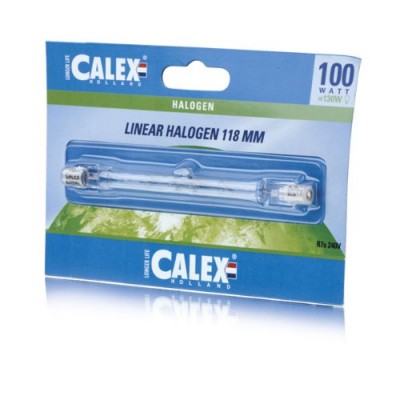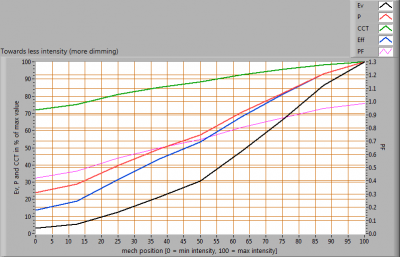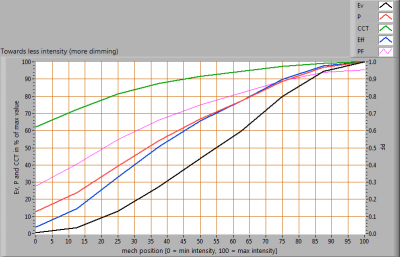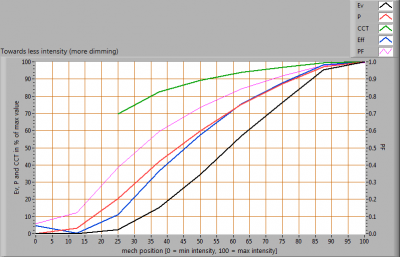Dimming of linear halogen lamp with phase cut dimmers
Posted by Marcel van der Steen in Explanation, Lamps No Comments»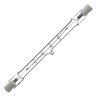 This is an article that shows the dimming results of a linear halogen light bulb that is dimmed by forward phase-cut (LR) and backward phase-cut dimmers (tronic, RC). The halogen lamp is well dimmable in the sense of dimming the amount of light. The images created show what that means in terms of light output as a function of dim-position.
This is an article that shows the dimming results of a linear halogen light bulb that is dimmed by forward phase-cut (LR) and backward phase-cut dimmers (tronic, RC). The halogen lamp is well dimmable in the sense of dimming the amount of light. The images created show what that means in terms of light output as a function of dim-position.
What is remarkable is the amount of power still being high when the light has been dimmed a lot.
The graphs can be used to compare other types of lamps that are dimmed, in order to be able to judge whether the dimming works well or not.
The halogen lamp that was used
This was a linear halogen lamp in tube form, with an R7s connection. The brand was Calex.
Dim results
The GIRA LR dimmer, a forward phase-cut dimmer
Dimming with the Gira LR Dimmer.
When inserting the dimmer at its no dimming position and the comparing with the situation without dimmer, then the influence on the following parameters is measured (negative value is increase):
– the illuminance: 8 %;
– the consumed power: 3 %.
The intensity is variable in the mechanical area between 0.0 – 100.0 %.
The dimmer set in that area results in a variation of the illuminance between 3 – 100 % (note that in that 100 % the drop in illuminance when inserting the dimmer is not counted, see for that value above).
There is a huge effect on the color temperature when dimming is increased. From 2885 K to 2061 K.
The remaining power consumption at maximal dimming position is 34 W. So still a lot of power is consumed when dimming down to 3 % light.
The BERKER RC dimmer, a reverse phase-cut (tronic, RC) dimmer
Dimming with the Berker RC Dimmer.
When inserting the dimmer at its no dimming position and the comparing with the situation without dimmer, then the influence on the following parameters is measured (negative value is increase):
– the illuminance: 14 %;
– the consumed power: 7 %.
The intensity is variable in the mechanical area between 0.0 – 100.0 %.
The dimmer set in that area results in a variation of the illuminance between 1 – 100 % (note that in that 100 % the drop in illuminance when inserting the dimmer is not counted, see for that value above).
There is a huge effect on the color temperature when dimming is increased. From 2887 K to 1767 K.
The remaining power consumption at maximal dimming position is 18 W. So still a lot of power is consumed when dimming down to 2 % light.
The low cost LR dimmer, a forward phase-cut dimmer
Dimming with the low-cost LR Dimmer.
When inserting the dimmer at its no dimming position and the comparing with the situation without dimmer, then the influence on the following parameters is measured (negative value is increase):
– the illuminance: 6 %;
– the consumed power: 1 %.
The intensity is variable in the mechanical area between 0.0 – 100.0 %.
The dimmer set in that area results in a variation of the illuminance between 0 – 100 % (note that in that 100 % the drop in illuminance when inserting the dimmer is not counted, see for that value above).
There is a huge effect on the color temperature when dimming is increased. From 2875 K to 1996 K.
The remaining power consumption at maximal dimming position is 0.2 W. So 0 power at 0 light output. However when dimming to 25 % of light output (the 45 % dim position) there is still more than 50 % of power consumed. This is typical for halogen and incandescent light bulbs. When these are dimmed the light output decreases, this decreases the wire temperature and that decreases the efficacy.
